All 3 entries tagged Reception
No other Warwick Blogs use the tag Reception on entries | View entries tagged Reception at Technorati | There are no images tagged Reception on this blog
November 01, 2018
Fantasy Coins

This coin looks like a Roman coin. It is circular, it bears the head of the emperor, in this case Nero, and the legend (the writing on the coin) appears around the head. It is made of copper rather than the mixed-alloy bronze that was common in the Roman imperial period. However, the intent of the maker is to make a low value denomination. The lettering S C on the reverse (tails side) is a common feature for Roman issues in bronze, and the appearance of monuments, like the Ara Pacis in this case, is well attested. However, this is not a Roman coin, nor is it a modern imitation. This is a Fantasy coin; a coin reflecting the currency of a fantasy or an alternative history world.
Fantasy coins are produced by a number of different modern companies in response to the explosion of interest in fantasy games, such as Dungeon and Dragons. The coins can reflect specific worlds, such as Westoros (the world of Games of Thrones) or ancient Rome. Other ranges relate to generic fantasy worlds, particularly a specific racial or cultural group in that world. Elvish, dwarvern, barbarian, dragon and orcish communities are among the many catered for. Futuristic coins, representing the coins of imagined galactic empires, are also produced. In order to relate the coin to the subject matter, the images on the coin and more occasionally its shape are utilised. Such images are based on popular tropes related to the fantasy race. Dwarvern coinage for instance tend to show anvils, hammers and bear Nordic runes, ultimately derived from a Norse description of dwarfish smiths in the Prose Edda, a medieval text detailing Scandinavian myths. Orc coins often bear weapons or warriors, reflecting the original inspiration of orcs from Tolkien as creatures obsessed with war.
In many cases, a specific range of Fantasy coins is not tied to a particular game. The generic imagery is used so that the pieces can be accommodated in a number of different settings, allowing for a wider array of customers. The general audience of these coins are gamers and curiosity collectors, though these are often not separate groups. Players of “roleplaying” games, in which the players control characters in an imagined setting, with one player known by various names (Game Master, Dungeon Master or Keeper among many others) guiding the story. In these contexts, props are often utilised. These primarily consist of miniature figures representing the characters and their opponents, but increasingly other props are utilised to increase the immersion in the game. This is particularly evident in the real-world equivalent of role-playing, larping (otherwise known as live-action roleplaying) in which the participants physically portray their characters through costume and acting. Props are particularly valued in such settings, and the organisers of these events often produce their own coins. There are even events where complex denomination systems accompany the coins. For these groups, the coins are often bought in bulk. However, individual coins are also available for purchase. These would not be suited to games that require many coins, so these coins have a premium on their artistic value. As a result, Fantasy coins tend to be larger than most modern coins, and they often bear high quality designs. The Ancient Greeks also produced large coins with high quality images, so the use of coins as aesthetic pieces marks a continuation of an ancient tradition.
One would think that the coins would be highly unusual, as they are products of imagination. However, most fantasy coins are almost identical to the coins produced in the ancient period. The majority of fantasy coins are depicted as round objects, with an image on each side. Most ranges of fantasy coins have three separate denominations, with a gold, silver and copper issue. The only differences are the subject matter of images upon the coins and that they are not usually made of precious metal (like gold or silver), unlike the ancient coins which were intrinsically valuable in their own right. Since coinage began in 7th century BC Turkey, coins in the western world have retained the same features. Even Bitcoin is represented as a circular object, despite its digital form itself having no physical shape. Fantasy coins, for all the imagination behind them, are slaves to the trope. There are a few attempts to get away from round coinage for particularly exotic cultures, with some coins represented as moons, axe heads or as hexagons. In most cases, however, the producers of these coins are bound to their customers’ understanding of what a coin should look like.
Returning to our Fantasy Coin example, the coin copies a Roman issue in terms of its iconography (e,g, RIC 1 527). It is not, however, an imitation. The size of the original Roman denomination, an as, is not copied. As with other fantasy coins, the Nero coin is part of a series of gold, silver and copper coins, classed under the title “Roman”. As the smallest denomination, the coin is the smallest size in the series, whereas the gold coin is the largest coin of the set. In the ancient world, the size difference in coins was usually unnecessary; gold coins were intrinsically more valuable due to their metal content, so even the smallest gold coin was more valuable than the largest bronze coin and bronze coins were generally larger in antiquity. However, for modern Fantasy coins it would seem that bigger is better, so the highest denomination is afforded the largest size, and thus the greatest prestige. Within the series is a silver coin depicting a Constantine issue, and a gold coin bearing the Republican head of Roma, the titular goddess of Rome, with Jupiter riding a chariot alongside Victory on the reverse. The latter image was prominently featured on silver coins struck during the Roman Republic; the placement of the image on a gold coin here indicates that the modern manufacturer saw this image as worthy of a higher value.
|
|
|
Historical accuracy is not the intention behind these coins. What matters is the modern audience’s perception of what a coin is and what Roman culture was. Hence the more valuable coins are larger and the images chosen are ones that reflect “Roman-ness”. Hence emperors, monuments and famous gods are preferred over other images, like the many personifications of lesser deities that decorate the majority of ancient Roman coins. However, the manufacturers have chosen to imitate Roman coins rather than create their own images, so there is a modern desire for “authenticity” in some sense that the producers of these pieces are accommodating. This is not always the case; Fantasy Spartan coins exist, yet in reality the Spartans had no coins. As a result, standard pieces of Greek military equipment, like the Corinthian style helmet, are utilised for the iconography of these pieces.

The expansion in the Fantasy coin trade represents a continuation of coins as an art form. From their beginnings, coins in Europe bore high quality designs. The Rennes Patera show that certain individuals collected coins and valued them for the iconography upon them. There is little difference here.
Fantasy coins have yet to receive any major academic study. Yet studying these coins in an academic fashion is of great use in understanding modern conceptions. This is particularly true of the “historical” ranges of Greek and Roman coins. As a form of reception studies, one can see what particular images a modern audience considers as being “most Roman” or “most Greek”. The more fantastical ranges are also of interest, as it would be curious what real-world influences are attributed to these fictional races. Overall, the production of Fantasy coins shows that in the modern world where most transactions are carried out online or through credit, coins continue to attract interest.
 |
This month's coin was written by David Swan. David is a postgraduate researcher at the University of Warwick. His thesis examines coinage and hoarding patterns across the Channel in Iron Age Europe. He specialises in Iron Age (otherwise known as Celtic) coinage.
January 01, 2014
Medal of Cosimo de' Medici, Pater Patriae
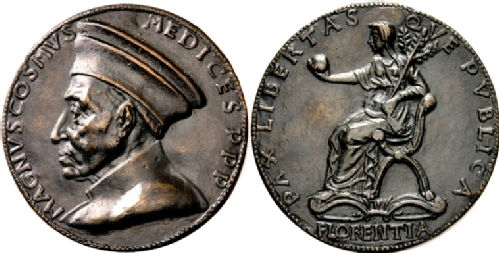 |
| Medallion of Cosimo I de'Medici as Pater Patriae |
This bronze medal is the earliest example of a product created by the Florentine school. It celebrates Cosimo I de’Medici (1389-1464). He was the head of the de’Medici family, a family of bankers who were the de facto rulers of Florence during most of the Italian Renaissance. Cosimo I was granted the title Pater Patriae by the Florentine Signoria after his death on 1 August 1464. According to some scholars, the title was actually conferred on him through a decree dated to 20th August 1464, while others argue that he was granted this title through a decree dated to March 16th 1465. However, the medal was certainly not produced after 1469, the year of Piero il Gottoso’s death; the latter was the dedicatee of an Aristotelian manuscript —Florence, Biblioteca Medicea Laurenziana, Ms Plut. 84, I, c. 3— which was produced by Francesco di Antonio del Chierico on behalf of Piero di Lorenzo de’Medici. Indeed, the effigy of the medal was copied in an illumination of the manuscript by Francesco del Chierico.
The obverse of the medal presents the bust of Cosimo I in profile, facing left. He is wearing a flat beret, which was proper for persons of high rank, and a buttoned cloak. The circular legend, in Roman capital letters, reads as follows: MAGNVS COSMVS MEDICES P(RIMVS) P(ATER) P(ATRIAE).
The reverse shows a female figure, seated on a throne, which is the allegory of Florence: indeed the exergue reads FLORENTIA. The figure is inspired by Graeco-Roman coins depicting Concordia. She is wearing a peplos and is veiled, likely as a sign of mourning for Cosimo. In her left hand she holds an olive branch ending in three shoots. In the other hand, stretching forward, she grasps a globe, which might recall the Medici family emblem: a set of red balls on a gold shield. The folding seat of Florentia is placed upon a yoke on the ground. The circular legend of the reverse reads PAX LIBERTASQVE PVBLICA.
A golden exemplar of the medal is shown in a relief in gilded stucco inset into the Portrait of a Young Man with a Medal of Cosimo il Vecchio by Botticelli, now preserved in the Uffizi. The likeness of Cosimo de’ Medici depicted in the medal also inspired numerous posthumous portraits of him, including that by Jacopo Pontormo in the Uffizi.
Many different artists have been proposed for the medal’s creator: Niccolò di Forzore Spinelli, Donatello, Michelozzo, Cristoforo di Geremia, and Bertoldo di Giovanni. Nevertheless, the controversial question concerning the author’s identification basically remains a mystery. According to a fascinating interpretation, the young man depicted in the portrait by Botticelli might be the designer of the medal, Antonio Botticelli, the painter’s brother. Antonio Botticelli had indeed recast and gilded medals, working in the court of the Medici family.
The whole idea of a ʽportraitʼ on coins, as shown here, as well as the title pater patriae, was inspired by the rediscovery of Roman coins in the Renaissance, as medieval coinage did not have portraits. Ancient coins, especially the Roman imperial sestertii, were the subject of interest and intense study among Renaissance scholars from the early fifteenth century onwards. These coins were admired by humanists for their large size, their high relief, and the use of bronze, which was rarely used for medieval coinage. As a result of a process that started in the thirteenth century, various minting authorities introduced significant innovations in the appearance of the circulating coinage. Additionally, the influence of some aspects of ancient coinage resulted in the creation of a new artistic medium in the medal.
A substantial difference between Roman imperial coins and their medieval counterparts was, first of all, the profile portrait bust of a ruler on the obverse, and secondly the representation of classical deities, contemporary scenes or monuments on the reverse. Coins of the later Middle Ages did not have the reverse exergue line, often with letters beneath it, and the legends were less detailed and written in the Gothic letters derived from medieval book hands rather than the Roman capital letters used on imperial coins.
 This month’s coin was chosen by Rocco Di Dio, a third-year PhD student. His research project focusses on three Greek manuscripts produced by the Renaissance scholar Marsilio Ficino (1433-1499), who was largely responsible for the revival of Platonism in western Europe. Rocco’s main interests lie in Palaeography, Codicology, Byzantine Studies, Platonic philosophy and the Renaissance reception of Platonism.
This month’s coin was chosen by Rocco Di Dio, a third-year PhD student. His research project focusses on three Greek manuscripts produced by the Renaissance scholar Marsilio Ficino (1433-1499), who was largely responsible for the revival of Platonism in western Europe. Rocco’s main interests lie in Palaeography, Codicology, Byzantine Studies, Platonic philosophy and the Renaissance reception of Platonism.
(Image above reproduced courtesy of Dr. Busso Peus Nachfolger, Auction 400, lot 1332)
September 01, 2013
A Roman denarius and Renaissance medallion showing a pileus and daggers
(Coin of the Month March 2013)
This famous silver denarius celebrates the murder of Julius Caesar in 44 BC. 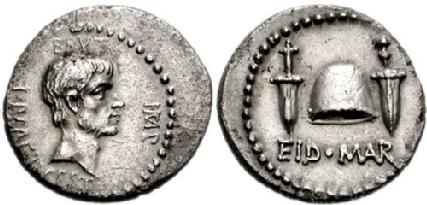 It was minted by Marcus Iunius Brutus in northern Greece during the late summer of 42 BC, for he had fled Rome after the assassination. Soon after, at the second Battle of Philippi, Brutus and his fellow conspirators were defeated by Mark Antony and Octavian, and he committed suicide. The obverse of the coin presents a bareheaded Brutus, with the legend “Brutus, Imperator, Lucius Plaetorius Cestianus (moneyer).” Republican coins did not display portraits of living men, but on this denarius Brutus included his own effigy and his title of Imperator, more in line with the coins of Julius Caesar, the man he had killed for supposedly wanting to be king. The reverse shows the cap of liberty (pileus), which was traditionally given to slaves on manumission, between two daggers. The chilling legend underneath reads EID(ibus) MAR(tiis)(Ides of March). Therefore, on one side of the coin Brutus claims to have liberated the fatherland and saved the Republic, but on the other side he presents himself as a general in the style of Julius Caesar. A few years later, Octavian (Augustus) would succeed in using both kinds of self-advertisement to create the Principate, marking the end of the Republic and the beginning of the Roman Empire.
It was minted by Marcus Iunius Brutus in northern Greece during the late summer of 42 BC, for he had fled Rome after the assassination. Soon after, at the second Battle of Philippi, Brutus and his fellow conspirators were defeated by Mark Antony and Octavian, and he committed suicide. The obverse of the coin presents a bareheaded Brutus, with the legend “Brutus, Imperator, Lucius Plaetorius Cestianus (moneyer).” Republican coins did not display portraits of living men, but on this denarius Brutus included his own effigy and his title of Imperator, more in line with the coins of Julius Caesar, the man he had killed for supposedly wanting to be king. The reverse shows the cap of liberty (pileus), which was traditionally given to slaves on manumission, between two daggers. The chilling legend underneath reads EID(ibus) MAR(tiis)(Ides of March). Therefore, on one side of the coin Brutus claims to have liberated the fatherland and saved the Republic, but on the other side he presents himself as a general in the style of Julius Caesar. A few years later, Octavian (Augustus) would succeed in using both kinds of self-advertisement to create the Principate, marking the end of the Republic and the beginning of the Roman Empire.
The coin was imitated in Renaissance Italy. On 6 January 1537, the first Duke of 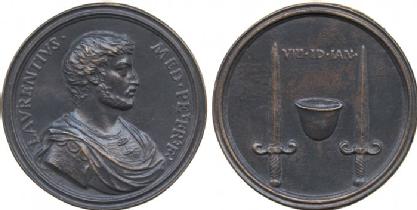 Florence, Alessandro de Medici, was murdered by his cousin Lorenzo di Pierfrancesco (Lorenzino or Lorenzaccio). Although the ultimate motives of Lorenzino are a subject of debate, his attempt to identify with Brutus and the model of classical tyrannicide is clear. In his Apologia he claims to have rid Florence of a tyrant. Also, Lorenzino followed the design of the Brutus denarius in his bronze medal, but in this case the daggers and pileus are inverted. He is even depicted wearing Roman dress and the date of the murder is VIII.ID.IAN, or eight days before the Ides of January.
Florence, Alessandro de Medici, was murdered by his cousin Lorenzo di Pierfrancesco (Lorenzino or Lorenzaccio). Although the ultimate motives of Lorenzino are a subject of debate, his attempt to identify with Brutus and the model of classical tyrannicide is clear. In his Apologia he claims to have rid Florence of a tyrant. Also, Lorenzino followed the design of the Brutus denarius in his bronze medal, but in this case the daggers and pileus are inverted. He is even depicted wearing Roman dress and the date of the murder is VIII.ID.IAN, or eight days before the Ides of January.
The French Revolution also expressed interest in Brutus and his coin. In March 1792, an article on the bonnet rouge mentions an extremely rare piece, ‘une superbe medaille d’or … antique et d’un beau travail,’ representing Brutus on one side and a bonnet between two daggers on the other side. The author proudly notes that the red bonnet of the revolutionaries is similar to the pileus in shape and in meaning: “this woollen bonnet was, in Greece and Rome, the emblem of freedom from slavery, and the rallying sign for all enemies of despotism” [Révolutions de Paris, no.141]. Finally, along with other classically-inspired symbols, the bonnet rouge made its way to America, and it can be found in the coats of arms of many countries today.
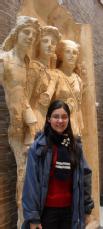 This month’s coin was chosen by Desiree Arbo, a first year PhD student. Desiree’s research focuses on the reception of Rome in 19th century Paraguay (South America). She is interested in the way elite thinkers used classical imagery and the idea of Rome in constructing the Paraguayan nation.
This month’s coin was chosen by Desiree Arbo, a first year PhD student. Desiree’s research focuses on the reception of Rome in 19th century Paraguay (South America). She is interested in the way elite thinkers used classical imagery and the idea of Rome in constructing the Paraguayan nation.
(Coin images above reproduced courtesy of Classical Numismatic Group Inc., (www.cngcoins.com) and Baldwin's Auctions Ltd [Auction 64, lot527])
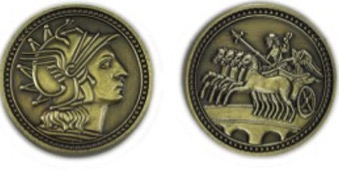
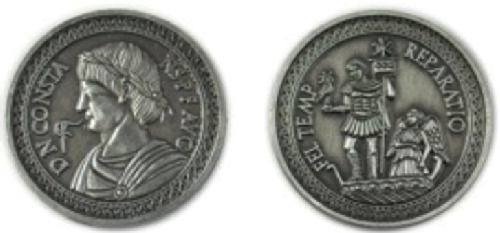
 Clare Rowan
Clare Rowan

 Please wait - comments are loading
Please wait - comments are loading

 Loading…
Loading…

